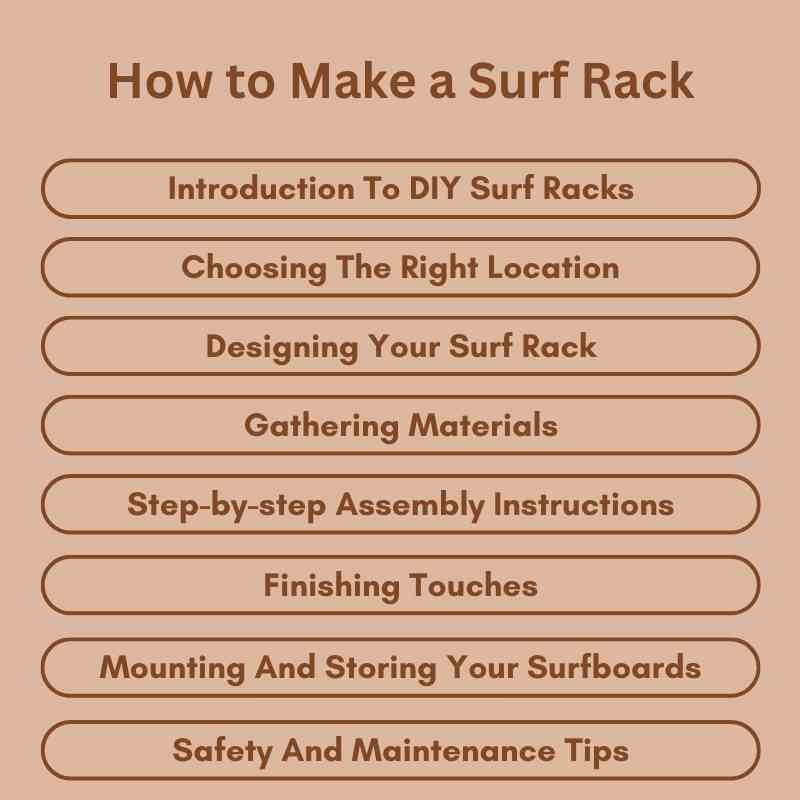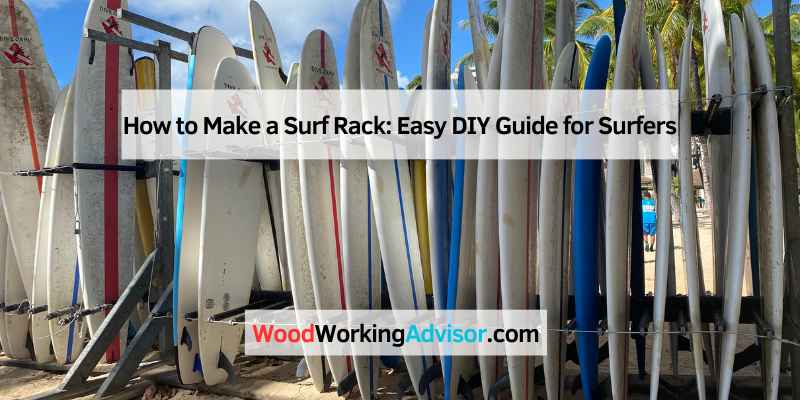To make a surf rack, gather materials like wood and screws. Assemble the frame and secure it to your wall.
Building a surf rack is an essential project for any surfing enthusiast. A well-constructed rack keeps your boards organized and protected from damage. It also saves valuable space in your garage or home. Whether you have one board or several, creating a custom rack can enhance your surfing experience.
This DIY project is not only functional but also adds a personal touch to your space. With basic tools and a little creativity, you can design a surf rack that fits your style and needs. Let’s dive into the steps and materials required to create a sturdy and reliable surf rack.
Introduction To DIY Surf Racks
Building your own surf rack can be fun and rewarding. It allows you to customize your storage solution. DIY surf racks save money and fit your specific needs. Follow this guide to learn how to create one.
The Benefits Of Building Your Own
- Cost-Effective: Save money compared to store-bought options.
- Customization: Tailor the design to fit your space.
- Durability: Choose materials that suit your environment.
- Skill Development: Improve your woodworking and building skills.
- Satisfaction: Enjoy the pride of creating something yourself.
Essential Tools And Materials
Gather these tools and materials for your DIY surf rack:
| Tools | Materials |
|---|---|
| Drill | Wood (Plywood or 2x4s) |
| Saw | Wood Screws |
| Measuring Tape | Sandpaper |
| Level | Wood Glue |
| Paintbrush | Finish (Paint or Varnish) |
Make sure to have all tools ready before starting. Choose quality materials for a sturdy rack.

Choosing The Right Location
Finding the perfect spot for your surf rack is key. The right location keeps your boards safe and makes access easy. Consider these factors: indoor vs. outdoor options, space availability, and ease of use.
Indoor Vs. Outdoor Racks
Both indoor and outdoor racks have unique benefits. Choose based on your needs and available space.
- Indoor Racks:
- Protects boards from weather.
- Less space required.
- Can be decorative.
- Outdoor Racks:
- Easy access after a surf.
- More visibility for friends.
- Requires weather-resistant materials.
Space Considerations And Accessibility
Space is crucial for your surf rack. Consider both the size of your boards and the area available.
| Space Type | Ideal Dimensions | Notes |
|---|---|---|
| Small Room | 4×2 ft | Vertical racks save space. |
| Garage | 6×3 ft | Easy access for multiple boards. |
| Outdoor Area | 8×4 ft | Ensure stability against wind. |
Consider accessibility as well. Ensure you can reach your boards easily. Place racks near your car or entryway for convenience.
Designing Your Surf Rack
Creating a surf rack requires careful planning. A well-designed rack holds your boards safely. It also keeps your space organized. Here’s how to design your perfect surf rack.
Types Of Surf Racks
Surf racks come in various styles. Each type serves different needs. Here are the main types:
- Wall-mounted racks: Great for saving space indoors.
- Freestanding racks: Portable and easy to move.
- Vertical racks: Ideal for tight spaces.
- Horizontal racks: Suitable for displaying multiple boards.
Customizing For Board Size And Quantity
Every surfer has unique needs. Customization ensures your rack fits perfectly. Consider these factors:
- Board sizes: Measure your boards’ lengths and widths.
- Number of boards: Decide how many boards to store.
- Material: Choose wood, metal, or PVC for durability.
- Design: Select a style that matches your space.
Use a table for a clearer view:
| Type of Board | Recommended Rack Type | Space Needed (in FT) |
|---|---|---|
| Shortboard | Wall-mounted | 2 |
| Longboard | Freestanding | 4 |
| Funboard | Horizontal | 3 |
Choose wisely. A well-customized rack enhances your surfing experience.
Gathering Materials
Building a surf rack requires careful planning. Selecting the right materials is essential. The choice affects durability and functionality. Let’s dive into your options.
Wood Or Metal: Pros And Cons
| Material | Pros | Cons |
|---|---|---|
| Wood |
|
|
| Metal |
|
|
Screws, Nuts, And Bolts: What You’ll Need
Securing your surf rack needs the right fasteners. Choose quality materials for safety. Here’s what you need:
- Screws: Use wood screws for wood racks. Use stainless steel screws for metal.
- Nuts: Choose locking nuts. They prevent loosening.
- Bolts: Use bolts that fit your design. Ensure they are rust-resistant.
Gather these items before starting your project. A well-prepared builder saves time and effort.
Step-by-step Assembly Instructions
Building your own surf rack can be fun and rewarding. Follow these clear steps to create a sturdy and reliable surfboard rack. Each section covers essential tasks to complete your project smoothly.
Cutting And Shaping The Pieces
Start by gathering your materials. You will need:
- 2×4 lumber
- Wood screws
- Wood glue
- Saw
- Sandpaper
Follow these steps to cut and shape the pieces:
- Measure and mark your lumber.
- Cut two vertical pieces, each 6 feet long.
- Cut two horizontal pieces, each 4 feet long.
- Cut additional smaller pieces for support (1 foot long).
Use sandpaper to smooth all edges. This helps prevent splinters.
Assembling The Frame
Now, assemble the frame:
- Lay the vertical pieces upright.
- Attach the horizontal pieces at the top and bottom.
- Use wood screws for a strong hold.
- Add the smaller support pieces in between.
Check the frame for stability. Make sure everything is square and tight.
Mounting The Rack Securely
Mount the rack on the wall:
- Choose a location with enough space.
- Use a level to mark where to drill.
- Drill holes into the wall studs for extra strength.
- Attach the frame securely with screws.
Test the rack by placing a surfboard on it. Ensure it holds well before using it regularly.
Finishing Touches
Finishing touches enhance the look and functionality of your surf rack. This step includes sanding, finishing, and adding padding. These details ensure your rack looks great and protects your boards.
Sanding And Finishing
Sanding is crucial for a smooth surface. Start with coarse sandpaper, then use finer grits. This process removes rough spots and splinters.
Follow these steps:
- Use 80-grit sandpaper for initial sanding.
- Switch to 120-grit sandpaper for a smoother finish.
- Finally, use 220-grit sandpaper for a polished touch.
After sanding, apply a protective finish. Choose between wood stain or varnish. Stain enhances wood color, while varnish offers a shiny layer. Here’s a quick comparison:
| Finish Type | Benefits |
|---|---|
| Wood Stain | Enhances color, highlights grain. |
| Varnish | Provides shine, protects from moisture. |
Adding Padding For Board Protection
Padded surfaces prevent damage to your surfboards. Use foam or rubber padding. Secure it to the rack with adhesive or screws.
Follow these steps:
- Measure the rack’s width and height.
- Cut foam or rubber to fit.
- Attach padding securely using glue or screws.
Consider using different thicknesses:
| Padding Thickness | Recommended Use |
|---|---|
| 1/2 inch | General protection for all boards. |
| 1 inch | Extra protection for high-end boards. |
Mounting And Storing Your Surfboards
Properly mounting and storing your surfboards is crucial. It keeps them safe and extends their lifespan. Follow these tips for effective board storage.
Correct Placement Of Boards
Choosing the right spot for your surfboards is key. Consider these factors:
- Height: Place boards at eye level.
- Space: Ensure enough room around each board.
- Ventilation: Avoid damp areas to prevent mold.
Follow these steps for correct placement:
- Measure the height and width of your surf rack.
- Mark the spots for each board.
- Use padded racks to protect the boards.
Store boards nose up or tail up. This prevents pressure points. Keep the boards separated with padding.
Maintaining Your Surf Rack
Regular maintenance ensures longevity. Check your surf rack for:
- Loose screws or bolts
- Signs of wear or damage
- Rust on metal parts
Follow these tips for effective maintenance:
| Action | Frequency |
|---|---|
| Inspect for damage | Monthly |
| Clean with mild soap | Every three months |
| Repaint or touch up | As needed |
Keep your surf rack clean and organized. This helps prevent accidents. A well-maintained rack makes surfing more enjoyable.
Safety And Maintenance Tips
Building a surf rack is fun, but safety is crucial. Regular maintenance keeps your rack sturdy. Follow these tips to ensure your surf rack lasts and stays safe.
Regular Checks For Stability
Inspect your surf rack often. Look for any signs of wear and tear.
- Check screws and bolts for tightness.
- Examine wood or metal for cracks.
- Ensure the rack stands straight and balanced.
Perform these checks every month. Replace damaged parts immediately. A stable surf rack prevents accidents.
Protecting Against Weather Damage
Weather can harm your surf rack. Use these tips to protect it:
| Weather Type | Protection Method |
|---|---|
| Rain | Apply waterproof sealant. |
| Sun | Use UV-resistant paint. |
| Snow | Cover with a tarp during winter. |
| Wind | Anchor the rack securely to the ground. |
Check your surf rack after bad weather. Repair any damage quickly. Regular care extends the life of your surf rack.
Alternative Surf Rack Ideas
Creating a surf rack doesn’t have to be boring. Get creative with alternative surf rack ideas. These options use unique materials and designs. They can fit any space. Let’s explore some exciting options!
Using Recycled Materials
Recycling is a great way to build a surf rack. It helps the environment and saves money. Here are some ideas:
- Old Pallets: Stack and secure them to hold boards.
- Wooden Crates: Use crates for a rustic look.
- Plastic Bottles: Cut and shape them for small board storage.
- Old Furniture: Repurpose shelves or tables into racks.
These options are not only eco-friendly but also stylish. They add character to your surf space. Choose materials that suit your style!
Innovative Designs For Small Spaces
Small spaces require smart solutions. Here are some innovative surf rack designs:
- Wall-Mounted Racks: Save floor space by mounting on walls.
- Foldable Racks: Use racks that can fold away when not in use.
- Vertical Racks: Store boards upright to save space.
- Hanging Systems: Use hooks or straps from the ceiling.
These designs maximize space without sacrificing style. They keep your boards safe and organized. Choose what fits best in your area!

Frequently Asked Questions
How Do I Build A Surf Rack At Home?
Building a surf rack at home requires basic tools and materials. Start by choosing a sturdy wood or metal frame. Measure and cut pieces to size. Secure them with screws or brackets. Finally, mount the rack on a wall or stand it on the ground for easy access.
What Materials Do I Need For A Surf Rack?
To make a surf rack, you’ll need wood or metal, screws, and brackets. Use durable materials to withstand weight and weather. Foam padding can protect your boards. Additionally, consider paint or sealant to protect the rack from moisture and enhance its appearance.
Can I Customize My Surf Rack Design?
Absolutely! Customizing your surf rack allows for personal creativity and functionality. You can adjust dimensions and add features like hooks for accessories. Consider the number of boards you’ll store. Tailor the design to fit your space and aesthetic preferences.
Where Should I Install My Surf Rack?
Install your surf rack in a dry, accessible area. Ideally, choose a spot near your entryway or garage. Ensure there’s enough space for easy board retrieval. Avoid damp or humid locations to prevent damage. Proper placement will make your surfing gear easily reachable and organized.
Conclusion
Building your own surf rack is a rewarding project. It keeps your boards organized and easily accessible. With the right materials and steps, you can create a sturdy storage solution. Enjoy the process and customize it to fit your style.
Happy surfing, and may your new rack inspire many waves ahead!

